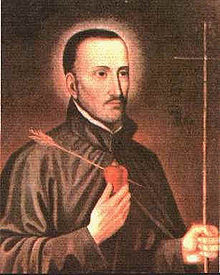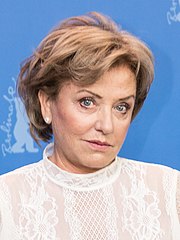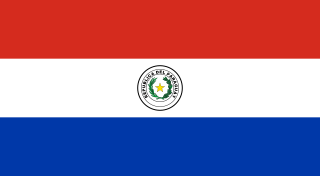
Paraguay, officially the Republic of Paraguay, is a landlocked country in South America. It is bordered by Argentina to the south and southwest, Brazil to the east and northeast, and Bolivia to the northwest. It has a population of around 6.1 million, nearly 2.3 million of whom live in the capital and largest city of Asunción, and its surrounding metro area.
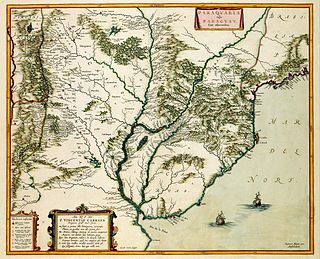
The history of Paraguay encompasses thousands of years of human habitation. Both agricultural and nomadic Guaycuruan lived in the region at the time of the Spanish Conquest. It became a relatively neglected part of the Spanish Empire due to its isolation and lack of mineral wealth, nonetheless a small group of Spanish settlers came to reside in the area, increasingly intermarrying with native women to produce a mestizo population. In the 17th and 18th centuries, Jesuit missionaries organized the natives into planned communities known as reducciones, and the experiment gained notable attention in Enlightenment Era Europe.
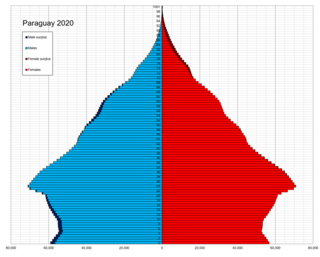
Demographic features of the population of Paraguay include population density, ethnicity, education level, health of the populace, economic status, religious affiliations and other aspects of the population.

Asunción is the capital and the largest city of Paraguay. The city stands on the eastern bank of the Paraguay River, almost at the confluence of this river with the Pilcomayo River. The Paraguay River and the Bay of Asunción in the northwest separate the city from the Occidental Region of Paraguay and from Argentina in the south part of the city. The rest of the city is surrounded by the Central Department.

Alto Paraná is a department in Paraguay. The capital is Ciudad del Este.
Latin Americans are the citizens of Latin American countries.
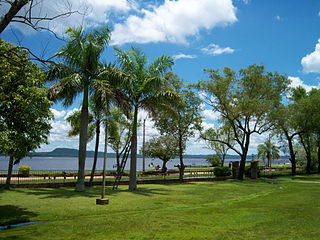
San Bernardino is a town in Paraguay, located on the shores of Ypacarai Lake in the Cordillera Department. It is a popular holiday resort for people from Greater Asunción.

Argentina has a racially and ethnically diverse population. The territory of what today is Argentina was first inhabited by numerous indigenous peoples. The first white settlers came during the period of Spanish colonization, beginning in the 16th century. The Spaniards imported African slaves, who would go on to become the first Afro-Argentines. Following independence from Spain in the 19th century and well into the 20th century, numerous migration waves took place, with Argentina being the second most popular destination for migrants in the early 20th century, after the United States. Most of these migrants came from Europe.

Football is by far the most popular sport in Paraguay. Paraguay's national team has played at eight FIFA World Cup competitions and has won two Copa América tournaments. Olimpia Asunción is the country's most successful club in domestic and international competitions. Paraguay's football leagues are divided into four divisions. In 2020, Paraguay's top-tier was ranked 8th in the world by the IFFHS.
White Latin Americans or European Latin Americans are Latin Americans of European descent.

Christianity is the predominant religion in Paraguay, with Catholicism being its largest denomination. Before the arrival of Spanish missionaries, the people residing in the territory of modern day Paraguay practiced a variety of religions.

Luis Szarán is a Paraguayan musician, orchestra director, composer and musical researcher; since 2002, founder and director of the social and community integration program "Sounds of the Earth", which created the school of music where began the Recycled Orchestra of Cateura.
Japanese Paraguayans are Paraguayans of Japanese ethnicity.
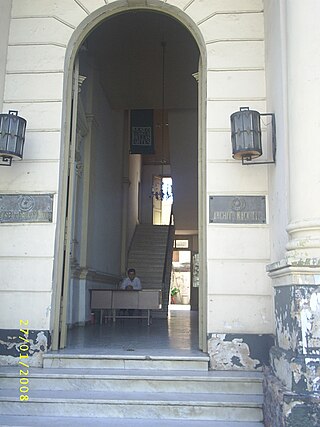
The National Museum of Fine Arts of Asunción, located on Mcal. Estigarribia and Iturbe St. in Asuncion, the capital city of Paraguay, displays over 650 works of art, paintings, sculptures, ceramics, prints, photographs, Paraguayan and international artists. As well as antique coins, furniture and various objects that belonged to its creator.
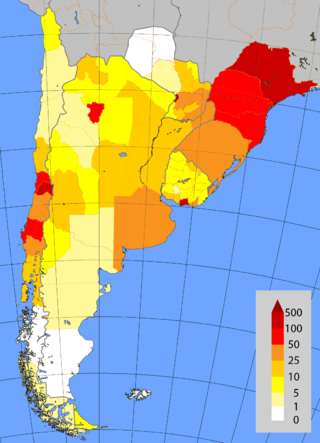
The Southern Cone is a geographic region composed of the southernmost areas of South America, mostly south of the Tropic of Capricorn. Although geographically this includes part of Southern and Southeastern Brazil, in terms of political geography the Southern cone has traditionally comprised Argentina, Chile, Paraguay, and Uruguay. In the narrowest sense, it only covers Argentina, Chile and Uruguay.

European Argentines or White Argentines belong to several communities which trace their origins to various migrations from Europe and which have contributed to the country's cultural and demographic variety. They are the descendants of colonists from Spain during the colonial period prior to 1810, or in the majority of cases, of Spanish, Italians, French, Russians and other Europeans who arrived in the great immigration wave from the mid 19th to the mid 20th centuries, and who largely intermarried among their many nationalities during and after this wave. No recent Argentine census has included comprehensive questions on ethnicity, although numerous studies have determined that European Argentinians have been a majority in the country since 1914.
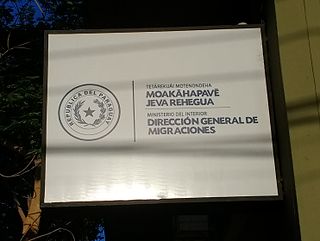
The Republic of Paraguay is a mostly bilingual country, as the majority of the population uses Spanish and Guaraní. The Constitution of Paraguay of 1992 declares it as a multicultural and bilingual country, establishing Spanish and Guaraní as official languages. Spanish, an Indo-European language of the Romance branch, is understood by about 90% of the population as a first or second language. Guaraní, an indigenous language of the Tupian family, is understood by 77%, and its use is regulated by the Academy of the Guaraní Language.

Carlos Alberto Filizzola Pallarés is a Paraguayan physician, labor unionist and politician who served as mayor of Asunción from 1991 to 1996, being the first one to be democratically elected. He later served four terms as senator, from 2003 to 2011 and again from 2012 to 2023, having been appointed Minister of the Interior in the meantime, under the presidency of Fernando Lugo. He was also the President of the Senate from 2005 to 2006 and the running mate of Domingo Laíno in the 1998 presidential election.

Italian Paraguayans are one of the most prominent ethnic group in Paraguay, consisting of Paraguayan-born citizens who are fully or partially of Italian descent, whose ancestors were Italians who emigrated to Paraguay during the Italian diaspora, or Italian-born people in Paraguay. Italian immigration to Paraguay has been one of the largest migration flows this South American country has received.

